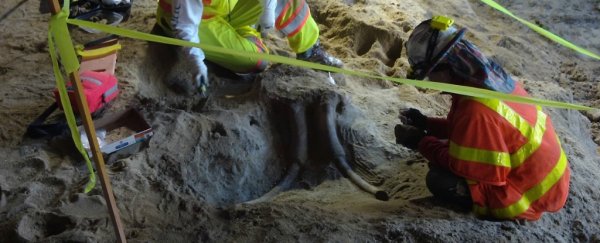Right before Thanksgiving, construction workers building an extension of Los Angeles' Metro Purple Line discovered something unusual under their feet: a 0.9-metre-long (3-foot-long) section of a tusk that researchers now say belonged to an ancient elephant.
The discovery was unearthed at the Wilshire and La Brea construction site roughly 4.5 metres (14 feet) below the Earth's surface, prompted officials to call in palaeontologists. Even cooler, they proceeded to find more remains just 3 metres (10 feet) away.
"This is significant; it's the very first mammal fossils that have been found on the Purple Line extension project," Metro spokesman Dave Sotero told Brittny Mejia from LA Times. "We've unearthed and we've preserved LA's prehistoric past as we build its future."
The second discovery – including a partial piece of skull and more tusk fragments – will hopefully allow researchers to accurately date and identify the specimen.
Right now, their initial hypothesis is that the remains are likely 10,000 years old, and belong to a mastodon.
The team has so far only created a plaster cast for the remains, which will be transported to the Natural History Museum in Exposition Park where they will be fully analysed by palaeontologists there.
One of the craziest things about this find is that fossils are routinely found in LA during construction, making the discovery seem like an everyday event there. In fact, it's so common that Metro officials pre-emptively plan to find fossils when putting together their construction timelines.
"We live in a very fossil-rich place," Emily Lindsey, a curator from the La Brea Tar Pits and Museum in LA, told LA Times. "There's a number of opportunities for palaeontologists just right here under LA."
The reason the area is so fossil-rich is because long ago it was covered by a vast amount of oil, which seeped to the surface, creating gigantic pools that were perfect for ancient animals to get stuck in.
Once stuck, these creatures couldn't escape so they sunk down into the muck, preserving them just under the surface, which is now being stripped back as construction takes place.
Mejia reports that in the 1980s, when the Metro was excavating to build its Red Line subway system, thousands of fossils were unearthed from these now underground tar pits, providing scientists with countless samples to study.
LA isn't the only Californian city that finds a lot of fossils, though.
Last year, construction workers building a road in the city of Carlsbad, which lies on the coast between LA and San Diego, unearthed a series of mammoth, horse, turtles, and bison fossils thought to be between 50,000 and 200,000 years old.
The latest find in LA will need further study before researchers can accurately identify the specimen or understand how old it truly is. And the team is waiting on further results before they publish anything in a peer-reviewed journal.
Until then, we can keep our fingers crossed that more fossils will be unearthed as construction continues.
